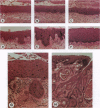Abstract
High-risk human papillomaviruses (HPVs), including type 16, have been identified as factors in cervical carcinogenesis. However, the presence and expression of the virus per se appear to be insufficient for carcinogenesis. Rather, cofactors most likely are necessary in addition to viral gene expression to initiate neoplasia. One candidate cofactor is prolonged exposure to sex hormones. To examine the possible effects of estrogen on HPV-associated neoplasia, we treated transgenic mice expressing the oncogenes of HPV16 under control of the human keratin-14 promoter (K14-HPV16 transgenic mice) and nontransgenic control mice with slow release pellets of 17beta-estradiol. Squamous carcinomas developed in a multistage pathway exclusively in the vagina and cervix of K14-HPV16 transgenic mice. Estrogen-induced carcinogenesis was accompanied by an incremental increase in the incidence and distribution of proliferating cells solely within the cervical and vaginal squamous epithelium of K14-HPV16 mice. Expression of the HPV transgenes in untreated transgenic mice was detectable only during estrus; estrogen treatment resulted in transgene expression that was persistent but not further upregulated, remaining at low levels at all stages of carcinogenesis. The data demonstrate a novel mechanism of synergistic cooperation between chronic estrogen exposure and the oncogenes of HPV16 that coordinates squamous carcinogenesis in the female reproductive tract of K14-HPV16 transgenic mice.
Full text
PDF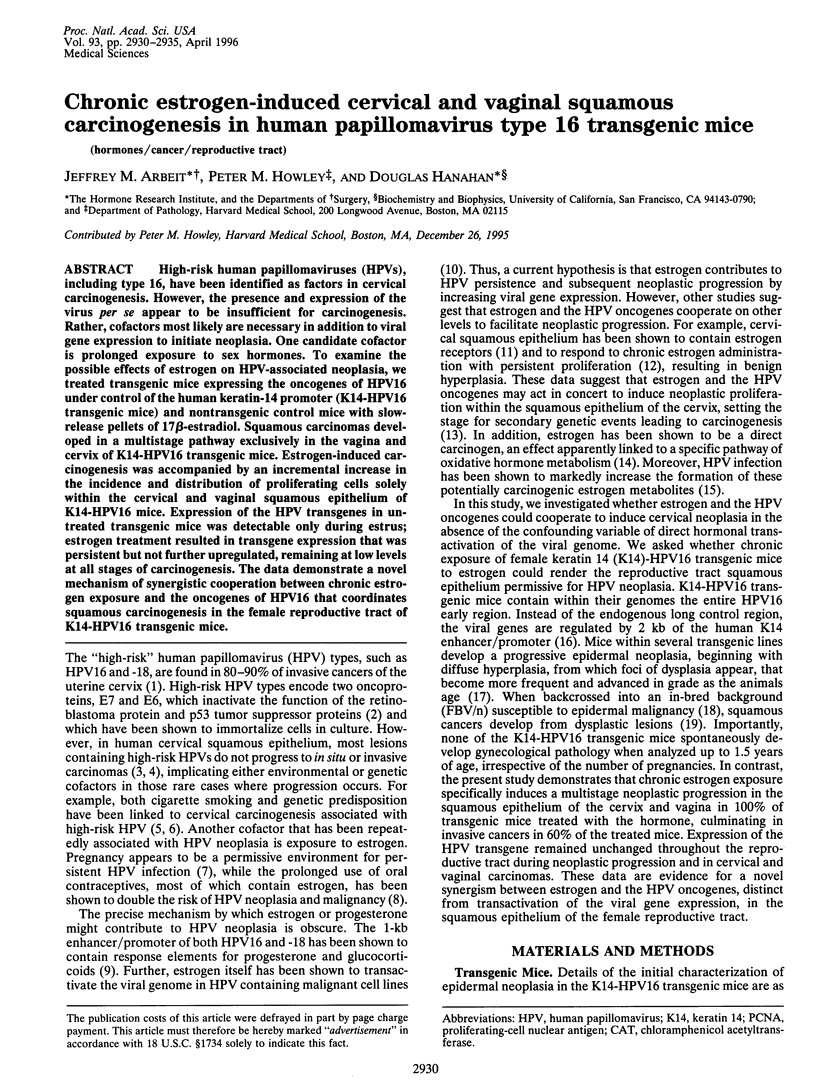
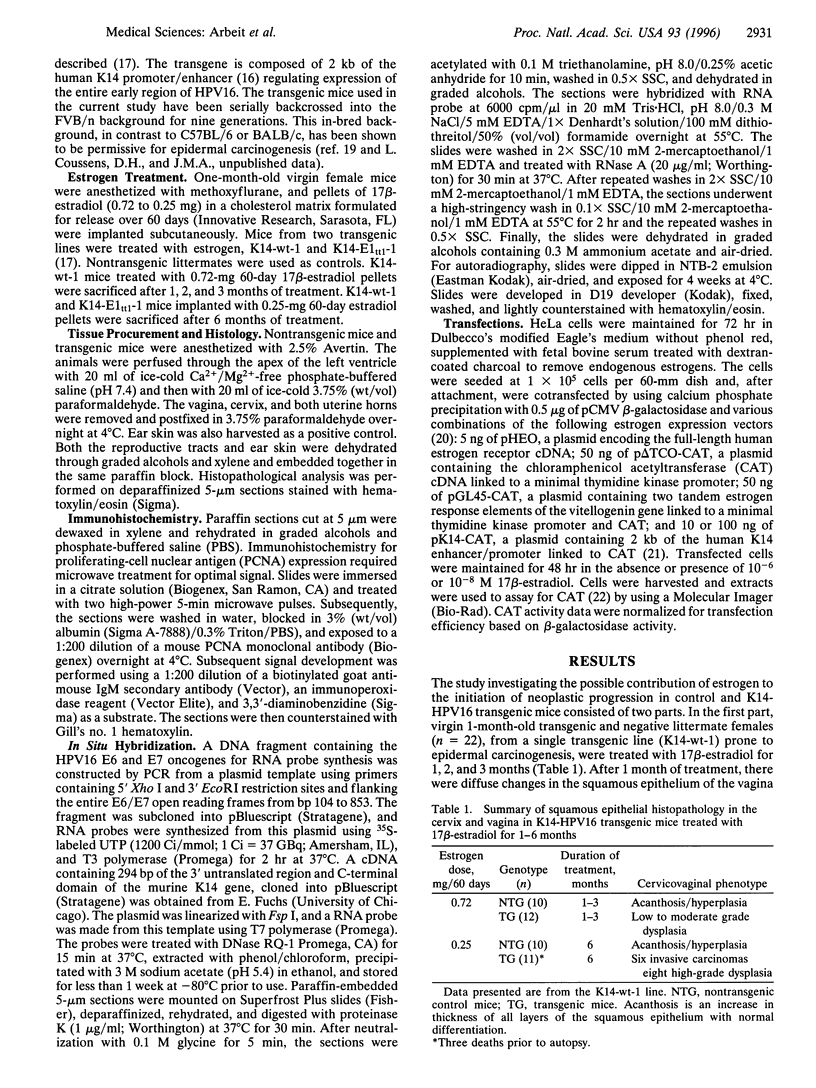
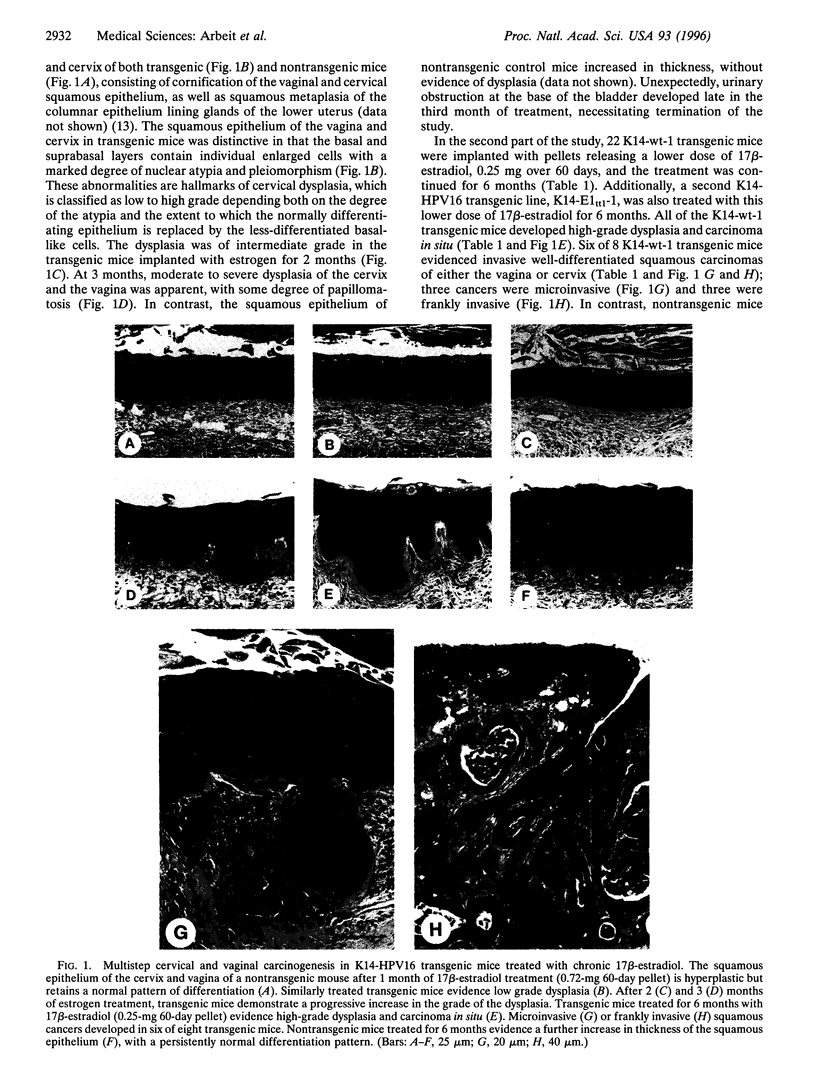
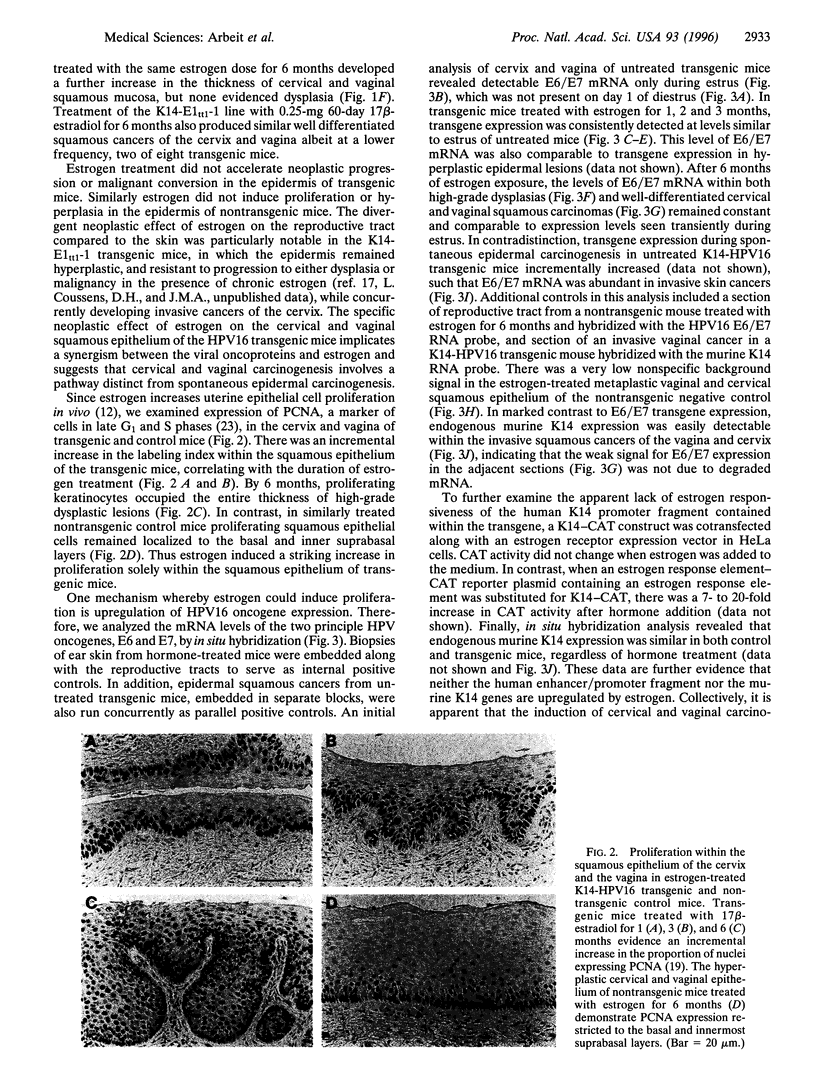
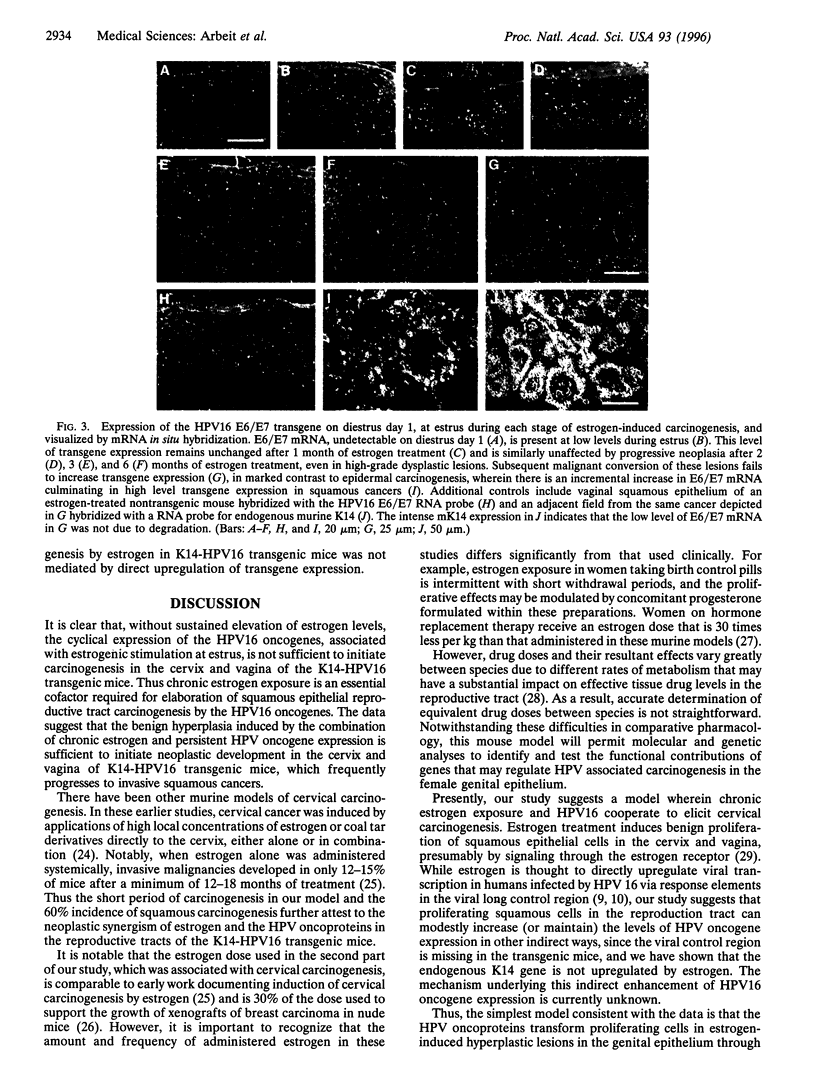
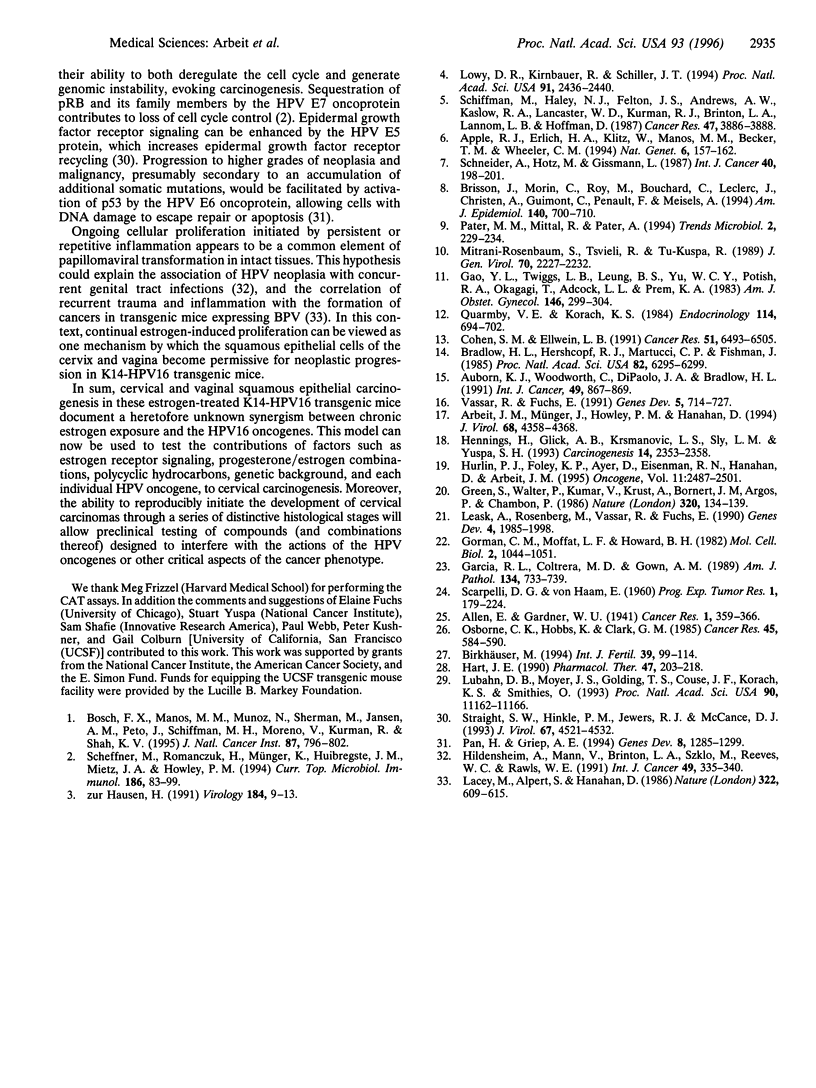
Images in this article
Selected References
These references are in PubMed. This may not be the complete list of references from this article.
- Apple R. J., Erlich H. A., Klitz W., Manos M. M., Becker T. M., Wheeler C. M. HLA DR-DQ associations with cervical carcinoma show papillomavirus-type specificity. Nat Genet. 1994 Feb;6(2):157–162. doi: 10.1038/ng0294-157. [DOI] [PubMed] [Google Scholar]
- Arbeit J. M., Münger K., Howley P. M., Hanahan D. Progressive squamous epithelial neoplasia in K14-human papillomavirus type 16 transgenic mice. J Virol. 1994 Jul;68(7):4358–4368. doi: 10.1128/jvi.68.7.4358-4368.1994. [DOI] [PMC free article] [PubMed] [Google Scholar]
- Auborn K. J., Woodworth C., DiPaolo J. A., Bradlow H. L. The interaction between HPV infection and estrogen metabolism in cervical carcinogenesis. Int J Cancer. 1991 Dec 2;49(6):867–869. doi: 10.1002/ijc.2910490611. [DOI] [PubMed] [Google Scholar]
- Birkhäuser M. Hormone replacement therapy and estrogen-dependent cancers. Int J Fertil Menopausal Stud. 1994;39 (Suppl 2):99–114. [PubMed] [Google Scholar]
- Bosch F. X., Manos M. M., Muñoz N., Sherman M., Jansen A. M., Peto J., Schiffman M. H., Moreno V., Kurman R., Shah K. V. Prevalence of human papillomavirus in cervical cancer: a worldwide perspective. International biological study on cervical cancer (IBSCC) Study Group. J Natl Cancer Inst. 1995 Jun 7;87(11):796–802. doi: 10.1093/jnci/87.11.796. [DOI] [PubMed] [Google Scholar]
- Bradlow H. L., Hershcopf R. J., Martucci C. P., Fishman J. Estradiol 16 alpha-hydroxylation in the mouse correlates with mammary tumor incidence and presence of murine mammary tumor virus: a possible model for the hormonal etiology of breast cancer in humans. Proc Natl Acad Sci U S A. 1985 Sep;82(18):6295–6299. doi: 10.1073/pnas.82.18.6295. [DOI] [PMC free article] [PubMed] [Google Scholar]
- Brisson J., Morin C., Fortier M., Roy M., Bouchard C., Leclerc J., Christen A., Guimont C., Penault F., Meisels A. Risk factors for cervical intraepithelial neoplasia: differences between low- and high-grade lesions. Am J Epidemiol. 1994 Oct 15;140(8):700–710. doi: 10.1093/oxfordjournals.aje.a117318. [DOI] [PubMed] [Google Scholar]
- Cohen S. M., Ellwein L. B. Genetic errors, cell proliferation, and carcinogenesis. Cancer Res. 1991 Dec 15;51(24):6493–6505. [PubMed] [Google Scholar]
- Gao Y. L., Twiggs L. B., Leung B. S., Yu W. C., Potish R. A., Okagaki T., Adcock L. L., Prem K. A. Cytoplasmic estrogen and progesterone receptors in primary cervical carcinoma: clinical and histopathologic correlates. Am J Obstet Gynecol. 1983 Jun 1;146(3):299–306. doi: 10.1016/0002-9378(83)90752-4. [DOI] [PubMed] [Google Scholar]
- Garcia R. L., Coltrera M. D., Gown A. M. Analysis of proliferative grade using anti-PCNA/cyclin monoclonal antibodies in fixed, embedded tissues. Comparison with flow cytometric analysis. Am J Pathol. 1989 Apr;134(4):733–739. [PMC free article] [PubMed] [Google Scholar]
- Gorman C. M., Moffat L. F., Howard B. H. Recombinant genomes which express chloramphenicol acetyltransferase in mammalian cells. Mol Cell Biol. 1982 Sep;2(9):1044–1051. doi: 10.1128/mcb.2.9.1044. [DOI] [PMC free article] [PubMed] [Google Scholar]
- Green S., Walter P., Kumar V., Krust A., Bornert J. M., Argos P., Chambon P. Human oestrogen receptor cDNA: sequence, expression and homology to v-erb-A. Nature. 1986 Mar 13;320(6058):134–139. doi: 10.1038/320134a0. [DOI] [PubMed] [Google Scholar]
- Hart J. E. Endocrine pathology of estrogens: species differences. Pharmacol Ther. 1990;47(2):203–218. doi: 10.1016/0163-7258(90)90087-i. [DOI] [PubMed] [Google Scholar]
- Hennings H., Glick A. B., Lowry D. T., Krsmanovic L. S., Sly L. M., Yuspa S. H. FVB/N mice: an inbred strain sensitive to the chemical induction of squamous cell carcinomas in the skin. Carcinogenesis. 1993 Nov;14(11):2353–2358. doi: 10.1093/carcin/14.11.2353. [DOI] [PubMed] [Google Scholar]
- Hildesheim A., Mann V., Brinton L. A., Szklo M., Reeves W. C., Rawls W. E. Herpes simplex virus type 2: a possible interaction with human papillomavirus types 16/18 in the development of invasive cervical cancer. Int J Cancer. 1991 Sep 30;49(3):335–340. doi: 10.1002/ijc.2910490304. [DOI] [PubMed] [Google Scholar]
- Hurlin P. J., Foley K. P., Ayer D. E., Eisenman R. N., Hanahan D., Arbeit J. M. Regulation of Myc and Mad during epidermal differentiation and HPV-associated tumorigenesis. Oncogene. 1995 Dec 21;11(12):2487–2501. [PubMed] [Google Scholar]
- Lacey M., Alpert S., Hanahan D. Bovine papillomavirus genome elicits skin tumours in transgenic mice. Nature. 1986 Aug 14;322(6080):609–612. doi: 10.1038/322609a0. [DOI] [PubMed] [Google Scholar]
- Leask A., Rosenberg M., Vassar R., Fuchs E. Regulation of a human epidermal keratin gene: sequences and nuclear factors involved in keratinocyte-specific transcription. Genes Dev. 1990 Nov;4(11):1985–1998. doi: 10.1101/gad.4.11.1985. [DOI] [PubMed] [Google Scholar]
- Lowy D. R., Kirnbauer R., Schiller J. T. Genital human papillomavirus infection. Proc Natl Acad Sci U S A. 1994 Mar 29;91(7):2436–2440. doi: 10.1073/pnas.91.7.2436. [DOI] [PMC free article] [PubMed] [Google Scholar]
- Lubahn D. B., Moyer J. S., Golding T. S., Couse J. F., Korach K. S., Smithies O. Alteration of reproductive function but not prenatal sexual development after insertional disruption of the mouse estrogen receptor gene. Proc Natl Acad Sci U S A. 1993 Dec 1;90(23):11162–11166. doi: 10.1073/pnas.90.23.11162. [DOI] [PMC free article] [PubMed] [Google Scholar]
- Mitrani-Rosenbaum S., Tsvieli R., Tur-Kaspa R. Oestrogen stimulates differential transcription of human papillomavirus type 16 in SiHa cervical carcinoma cells. J Gen Virol. 1989 Aug;70(Pt 8):2227–2232. doi: 10.1099/0022-1317-70-8-2227. [DOI] [PubMed] [Google Scholar]
- Osborne C. K., Hobbs K., Clark G. M. Effect of estrogens and antiestrogens on growth of human breast cancer cells in athymic nude mice. Cancer Res. 1985 Feb;45(2):584–590. [PubMed] [Google Scholar]
- Pan H., Griep A. E. Altered cell cycle regulation in the lens of HPV-16 E6 or E7 transgenic mice: implications for tumor suppressor gene function in development. Genes Dev. 1994 Jun 1;8(11):1285–1299. doi: 10.1101/gad.8.11.1285. [DOI] [PubMed] [Google Scholar]
- Pater M. M., Mittal R., Pater A. Role of steroid hormones in potentiating transformation of cervical cells by human papillomaviruses. Trends Microbiol. 1994 Jul;2(7):229–234. doi: 10.1016/0966-842x(94)90627-0. [DOI] [PubMed] [Google Scholar]
- Quarmby V. E., Korach K. S. The influence of 17 beta-estradiol on patterns of cell division in the uterus. Endocrinology. 1984 Mar;114(3):694–702. doi: 10.1210/endo-114-3-694. [DOI] [PubMed] [Google Scholar]
- SCARPELLI D. G., von HAAM Experimental carcinoma of the uterine cervix. Prog Exp Tumor Res. 1960;1:179–224. doi: 10.1159/000385939. [DOI] [PubMed] [Google Scholar]
- Scheffner M., Romanczuk H., Münger K., Huibregtse J. M., Mietz J. A., Howley P. M. Functions of human papillomavirus proteins. Curr Top Microbiol Immunol. 1994;186:83–99. doi: 10.1007/978-3-642-78487-3_5. [DOI] [PubMed] [Google Scholar]
- Schiffman M. H., Haley N. J., Felton J. S., Andrews A. W., Kaslow R. A., Lancaster W. D., Kurman R. J., Brinton L. A., Lannom L. B., Hoffmann D. Biochemical epidemiology of cervical neoplasia: measuring cigarette smoke constituents in the cervix. Cancer Res. 1987 Jul 15;47(14):3886–3888. [PubMed] [Google Scholar]
- Schneider A., Hotz M., Gissmann L. Increased prevalence of human papillomaviruses in the lower genital tract of pregnant women. Int J Cancer. 1987 Aug 15;40(2):198–201. doi: 10.1002/ijc.2910400212. [DOI] [PubMed] [Google Scholar]
- Straight S. W., Hinkle P. M., Jewers R. J., McCance D. J. The E5 oncoprotein of human papillomavirus type 16 transforms fibroblasts and effects the downregulation of the epidermal growth factor receptor in keratinocytes. J Virol. 1993 Aug;67(8):4521–4532. doi: 10.1128/jvi.67.8.4521-4532.1993. [DOI] [PMC free article] [PubMed] [Google Scholar]
- Vassar R., Fuchs E. Transgenic mice provide new insights into the role of TGF-alpha during epidermal development and differentiation. Genes Dev. 1991 May;5(5):714–727. doi: 10.1101/gad.5.5.714. [DOI] [PubMed] [Google Scholar]
- zur Hausen H. Human papillomaviruses in the pathogenesis of anogenital cancer. Virology. 1991 Sep;184(1):9–13. doi: 10.1016/0042-6822(91)90816-t. [DOI] [PubMed] [Google Scholar]



